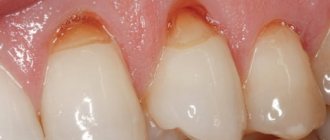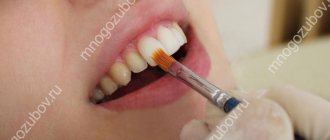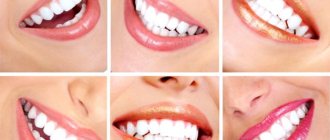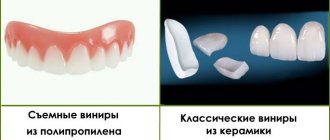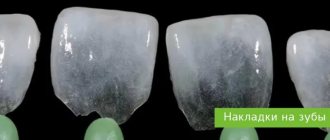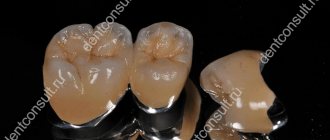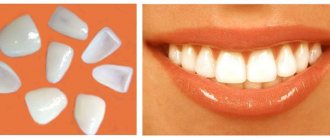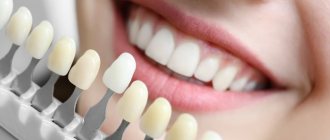Indications Contraindications How veneers are installed Pros and cons of veneering Veneers or braces Veneers or crowns
A beautiful, snow-white smile is one of the most common beauty standards. But perfectly straight teeth are quite rare. Some people have teeth that are too close to each other and crowd together, while others have teeth that are far apart, leaving gaps. Sometimes teeth are out of alignment or slightly tilted to the sides. Such defects are corrected by aesthetic dentistry. One of the common methods is veneering.
Veneers
– these are thin plates made of composite, ceramic or zirconium, which are used to correct a smile.
Place onlays on the front teeth, in the smile area. It is recommended to cover from 4 to 8 teeth
. The load on the lateral teeth is too strong for thin plates. It is better to put crowns on chewing teeth.
It is possible to install veneers on crooked teeth if certain conditions are met.
Indications for installation of veneers
- The presence of diastemas (gaps between the front teeth);
- chips, cracks, depressions, stains on the enamel;
- discoloration of teeth as a result of medical or dental treatment;
- single teeth protruding from a row;
- small, irregularly shaped teeth;
- slightly crooked teeth;
- gummy smile.
Veneers can correct the bite in the sense that in some cases, the onlays lift the bite, thus helping to bring back the “gone” lower jaw. This prevents problems with the temporomandibular joint and improves the quality of life.
To correct malocclusion, orthodontic treatment with braces or aligners (aligners) is necessary.
Is curvature of teeth a contraindication for installation?
Many patients would like to use veneers to hide all their imperfections at once, including uneven teeth. But the doctor may refuse an appointment. Why is this happening?
Here are the main contraindications to installing veneers.
- Unhealed foci of caries (but fillings, if they are installed well, will not hurt).
- Inflammatory diseases of the oral cavity, periodontal disease (until these problems are resolved, there is no need to carry out any aesthetic procedures).
- Malocclusion. Let's take a closer look here.
Veneers are plates that are installed using a special dental adhesive on the surface of the teeth. And teeth experience stress every day when chewing. The veneers themselves are not noticeable in any way, and patients with them eat exactly the same as before installation - there is no need to give up hard foods. Therefore, installed veneers must withstand daily “testing”. And if the bite is broken, then the cutting edges and chewing surfaces of the teeth close incorrectly. The load is distributed so that either the incisors or molars are overloaded. Because of this, the doctor simply cannot guarantee that the veneers will last as many years as they should.
This is a common practice: it is also impossible to install implants and even many types of crowns with an incorrect bite. For the same reason.
When is it better to refuse to correct your bite with veneers?
Like any intervention, veneering has limitations. The pads are not suitable for people suffering from bruxism. Grinding your teeth can ruin all your work. You should not install pads if you have the following pathologies in adults:
- periodontitis 3-4 degrees (teeth are very loose, gums are inflamed);
- thinning of enamel;
- significant damage to the crown (from 40%);
- lack of teeth in the area of prosthetics;
- severe curvature.
Sometimes it is possible to place veneers on crooked teeth after the condition improves or certain conditions are met. So, in case of infections, pregnancy, childhood, you just have to wait.
When are crowns used to straighten teeth?
If it is impossible to correct the crooked teeth with veneers, the doctor may offer the patient treatment using crowns. Like veneers, crowns can straighten one or more teeth.
They are usually installed on the front teeth. At the same time, dentures can restore teeth not only from an aesthetic point of view - with the help of crowns, functionality and anatomical shape are restored to damaged teeth.
It is important that the material for crowns is selected correctly - this will preserve the aesthetics of the teeth, and the installed structure will look natural, without causing discomfort to the patient. The best option is all-ceramic crowns. They best meet aesthetic requirements and, in terms of transparency and color, closely match natural teeth.
However, if you have a massive jaw, installing such crowns is not recommended. In this case, ceramic crowns, the frame of which is made of zirconium dioxide, are more suitable. If the smile area is subject to correction, then you should abandon metal-ceramic crowns, since they do not look entirely aesthetically pleasing.
How to install veneers
There are 2 ways to get a Hollywood smile:
- Install composite overlays directly in the doctor’s chair
- Make individual ceramic or zirconium plates based on an impression in the laboratory
The composite is inexpensive, installs quickly, and perfectly imitates enamel. Unfortunately, it is prone to shrinkage, absorbs pigments and wears out quickly.
Ceramic veneers are very durable, do not change color, and practically do not wear out. The main disadvantage is the cost.
The fact is that the process of making ceramic linings is expensive. It consists of several stages:
- Diagnosis and development of treatment plan
- Preparation: sanitation of the oral cavity, cleaning teeth from plaque
- Color selection
- Tooth preparation
- Taking impressions
- Record making
- Fitting
- Fixation
Consumables, the doctor's work, equipment, and the cost of the ceramics themselves make ceramic veneers more expensive than composite ones. But they do not need to be polished every 6 months and replaced every 3-5 years.
Price
The cheapest are composite veneers. They are easy to install; this is done by the doctor during the appointment. They are short-lived, easily change color, and become covered with cracks. Longer service life for ceramic veneers. They are resistant to coloring pigments, quite thin, which means minimal dental treatment is required. Zirconium veneers are the strongest, but also the most voluminous. The preparation for them is more pronounced, and it is quite difficult to secure them. Ultra-thin veneers require more effort, which is why they are the most expensive. But the enamel is practically not ground off underneath them.
Pros and cons of veneering
Dental overlays for correcting malocclusion not only make your smile attractive, they increase self-esteem and improve your psychological state.
Advantages of veneers:
- Short installation times
. Composite onlays require 1 appointment, and ceramic onlays require 2-3. - Exact imitation of enamel
. The ability to transmit light makes ceramics indistinguishable from natural teeth - Biological inertia
. Allergy is not a contraindication. - Resistant to pigments and dyes
. Unlike natural teeth, ceramics do not change color over time. - Durability
. Ceramic compounds are several times stronger than composite ones. - Wear resistance
. If the recommendations are followed, ceramic linings last up to 20-25 years. Plates are replaced more often because the cement (adhesive) that attaches them to the teeth wears out.
97%
[1] Veneers are functioning perfectly 7 years after installation.
83%
[2] – after 20 years.
Several factors influence the lifespan of veneers:
- doctor's qualifications;
- mastery of technique;
- compliance with manufacturing and fixation technology;
- quality of materials;
- patient compliance with recommendations.
Therefore, it is recommended to choose large clinics with their own dental laboratories. The dentist and technician work together in such centers, discuss problems and find the best ways to solve them. The third member of the team is the patient.
It must be remembered that no veneer, even the most durable, can resist cracking nuts or biting wire. But curvature can be corrected with plates in a high-quality and long-term manner only if the recommendations are followed.
Disadvantages of veneers:
- The need for tooth preparation. Once you install veneers, you won’t be able to refuse them.
- High price. However, in the long term, ceramic veneers pay off. They do not need to be regularly polished and replaced with new ones.
Adaptation period
The patient needs to visit the dentist 2 weeks after installation of veneers. A control study is carried out, during which the doctor finds out the following circumstances:
- what is the condition of the linings (how do they hold up);
- is there an allergic reaction;
- Is there an inflammatory process?
On average, a person gets used to the installed microprostheses within 3 weeks.
It is important to properly care for your veneers. This will increase their efficiency and extend their service life. After such a restoration, doctors recommend adhering to the following rules:
- avoid increased loads on chewing surfaces;
- carefully monitor oral hygiene;
- Visit your dentist regularly (at least once every six months).
What is better – correcting crooked teeth with veneers or braces?
Comparing these treatment approaches is difficult. Braces correct malocclusions, and veneers mask defects.
| Veneers | Braces | Aligners (aligners) | |
| Tooth preparation | The enamel is removed to a depth of 0.2-0.7 mm | Not carried out | Not carried out |
| Duration of treatment | Up to 2 weeks | Up to 2 years | Up to 3 years |
| Severity of defect | Lightweight | Deep | Deep |
| Diet changes | For 2-3 days | Yes, all the time of treatment | No |
| Care | No special care required, just be careful when using it | Careful hygiene required | Careful hygiene required |
When they say that veneers correct the bite, they mean the aesthetic aspect. Braces and aligners eliminate deep violations.
Questions and answers
Is it possible to hide or disguise a crooked tooth with a veneer?
Good afternoon Tell me, is it possible to hide/disguise it with a veneer if a tooth is crooked? On my right, the fang goes inside the jaw. I don’t want to get braces, and I can’t afford the money for mouthguards. It seems like the solution is veneers, but I need your preliminary advice.
Hello!
Theoretically, such defects can be corrected by installing veneers. However, only a doctor can answer you for sure based on the results of the examination. Come to our specialists for a free consultation, the doctor will explain to you all the details of veneer prosthetics and write out a treatment plan indicating the cost. Our clinic uses highly aesthetic Empress veneers made from ultra-strong ceramics. For more details and to sign up for a free consultation, please call +. Sincerely, Patient Support Center SIMPLADENT++8 800 333-53-41 Other questions
Treatment of bruxism
The diagnosis was made by dentist-neurologist E.V. Saxonova after examination: brux behavior, hypertonicity of the masticatory muscles with the formation of pathological spasm.
To treat bruxism, that is, to eliminate severe clenching and grinding of teeth, injections of a drug containing botulinum toxin are prescribed into the masticatory and temporal muscles. Treatment with botulinum toxin preparations (Botox, Lantox) gives a good effect for bruxism, relieving excess tension and reprogramming muscle function. Additionally, the patient is recommended to monitor the condition of the masticatory muscles during the day, consciously relaxing them.
Why patients choose veneers
It is logical to level something using leveling devices specially created for this purpose. In dentistry, these are definitely braces. Only they are able to correct the curvature of individual teeth or a row (both rows), eliminating this problem forever. But braces have a significant drawback: they require considerable time to use. Patients do not want to walk around with foreign “pieces” in their mouth for years. And invisible braces are expensive.
But there is a way to change everything almost immediately; in two weeks your teeth will be as good as new. And not only smooth, but also the desired whiteness. Tempting? Veneers, however, also have a drawback - to install them, you will have to ruin your own living teeth, even if not ideal, by grinding them down to the required size. But what does such a “trifle” mean compared to a white-toothed, even smile!
Veneers: before and after photos
Correcting crooked teeth with veneers
It’s decided – patients choose veneers. But it's not that simple. In many cases of crooked teeth, it is simply impossible to correct it with onlays.
You will need braces:
- if the teeth are in a crowded position;
- if there are wide gaps between the teeth;
- if the shift in the dentition is significant;
- if the curvature of the teeth is not one-sided, but they are all directed in different directions.
Correcting crooked teeth with braces
Veneers can be installed:
- How are veneers placed?
- with slight curvature of the dentition;
- if the crowding is minor;
- if there are gaps between some teeth;
- if there are chips or chips in the enamel.
Veneers can help correct small defects
Removal of wisdom teeth under sedation
When removing wisdom teeth, medical sleep was used - sedation. This is a type of anesthesia in which the patient does not feel pain, does not worry, and everything around him happens as if in a dream. The patient chose sedation, since in one operation it was possible to immediately remove all 4 wisdom teeth without discomfort.
Teeth whitening ZOOM 4
Since the patient wanted her smile to become brighter, it was proposed to whiten her teeth so that the light color of the restorations would harmonize with the color of the rest of her teeth.
Modern and safe teeth whitening ZOOM 4 was performed, which uses an LED lamp to activate the whitening gel.
Whitening makes your teeth several shades lighter.
Bite disorders and their features
To understand whether veneers will correct your bite, you first need to understand the types of abnormal occlusion. The canines and incisors have sharp edges, and the chewing teeth have ridges. With an anatomically correct bite, the cutting and chewing parts correspond to each other and close tightly. If this relationship is violated, doctors talk about the presence of defects. In dental practice, the following types of abnormal bite
:
- Open bite
. Appears in the presence of a hereditary predisposition, as well as congenital anomalies of the facial bones. With such a defect in the frontal zone, there is completely no contact between the jaws. - Distal bite
. A characteristic feature of the anomaly is protrusion of the upper jaw with partial or complete absence of contact between the incisors. There may or may not be contact between the molars. - Crossbite
. It is formed in the presence of developmental anomalies of both jaws. With this deviation, the lower jaw is shifted to the side, and the upper jaw is greatly narrowed. Therefore, the relationship between the rows is disrupted in both planes. - Mesial bite
. It is characterized by a complete lack of contact between the incisors and protrusion of the lower jaw. In mesial occlusion, contact between molars may be maintained. - Deep bite
. A characteristic sign of such an anomaly is a significant overlap of the lower incisors with the upper ones. This violation leads to rapid wear of the enamel, resulting in a risk of tooth decay.
In the formation of an abnormal bite, not only the teeth, but also the bones of the jaw and skull most often take part. This is why changing the bite with veneers is often not possible.
Rules for hygienic care of veneers
If proper care is followed, veneers can serve their owner for up to 15 years. In order not to lose microprostheses before this period, experts advise:
- do not bite nuts or crack seeds;
- brush your teeth twice a day, use an irrigator;
- rinse your mouth after eating;
- do not use toothpicks;
- Visit the dentist for a preventive examination twice a year.
The dental network offers services for aesthetic dental restoration with the installation of veneers. Our specialists are proficient in modern prosthetic techniques and regularly improve their professional level in Russian and foreign clinics. We have a system of family and cumulative discounts.
You can contact any of the branches of our dentistry in Moscow, located within walking distance from the metro:
- Art. Alekseevskaya (VDNKh district, etc. Mira), address: st. 3rd Mytishchiskaya house 3, building 2;
- Art. Shelepikha, address: Shelepikhinskaya embankment, address: building 34, building 1.
The smile of your dreams is achievable. Our specialists will make your wishes come true. Waiting for you!
Treatment of caries with a microscope
The removal of old fillings and treatment of dental caries was carried out using a microscope by endodontist Yu.A. Borisova. The microscope helps to better see the boundaries of the filling material when removing old fillings, the area affected by caries, thereby improving the quality of treatment and preserving maximum tooth tissue (microinvasive treatment).
Treatment was carried out over several visits. A total of 15 teeth were treated, old fillings were replaced with fillings made of light-curing composite in the color of the teeth, and the physiological shape of the teeth was restored.
Crowns and veneers for straightening teeth: advantages and disadvantages
Crooked teeth can be corrected with crowns and veneers. There are a number of advantages of such structures:
- Quickly achieve the desired result. Braces are worn for years; when using onlays and attachments on the teeth, the period is reduced to a month. It is possible to do it faster;
- Instant change in tooth shape and color;
- Complete absence of inconvenience after the manipulations;
- Restoring the function and anatomy of the tooth with the subsequent preservation of the properties given to the structure for years to come.
When choosing between braces and veneers to improve the appearance of teeth, the doctor, together with the patient, has to analyze several aspects of the task. Speed and price are, of course, important, but long-term retention of results is also important. For example, braces provide lifelong stability to the correct alignment of teeth. Veneers will not be able to prevent the relapse of dentition. Braces work on all teeth in a row, and veneers can correct the curvature of mainly the front teeth in the smile area.
Install veneers without grinding Luxneers teeth at Dr. Lopaeva’s clinic
Make an appointment
Or call +7(985)532-21-01
Help from a myofunctional therapist
Myofunctional therapist T.B. Zukor has developed exercises that establish and secure the tongue in the correct position. This is necessary to achieve a stable result in correcting the position of the teeth.
If you do not work with the tongue, then its incorrect pressure will eventually negate all the work of the braces, and the teeth will begin to unfold again. At Dial-Dent, orthodontists work in close collaboration with a myofunctional therapist, which significantly reduces the time spent wearing retention equipment after removing braces.
How to make your teeth straight
Medicine, of course, can do a lot to correct crooked teeth. Demand creates supply - this is the law of a market economy. And modern dentistry today offers many ways to make teeth straight and beautiful.
Table. Ways to correct crooked teeth
| Way | Description |
| Bracket systems | The most reliable, effective, but at the same time quite long (at least six months) and expensive way to correct crooked teeth. |
| Cap aligners | Orthodontic aligners, which after installation by the doctor are removed and put on by the patient himself. They cost less than braces, but require enormous self-discipline and organization. They need to be cleaned daily. Sometimes, in difficult cases of bite correction, you have to wear aligners for about two years. |
| Trainers | Transparent polyurethane overlays that can correct only minor curvature. They do not straighten the teeth, but only train the facial muscles, due to which a slight shift in the teeth is corrected. |
| Crowns | Today, this method of not correcting, but covering up malocclusions is used only in the most exceptional cases. It is labor-intensive, costly, and in order to install crowns on teeth, they must first be significantly destroyed. |
| Surgery | In even more exceptional cases, such as jaw dysplasia, surgery is used to straighten the jaw. |
| Lumineers and veneers | These thin plates placed on the teeth do not straighten the bite, but only mask it, covering crooked teeth from prying eyes. Their installation also requires damage to the teeth. Lumineers are thinner, but teeth under veneers are ground down, although only slightly. However, this method of achieving a Hollywood smile is perhaps the most popular. |
